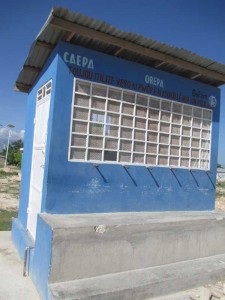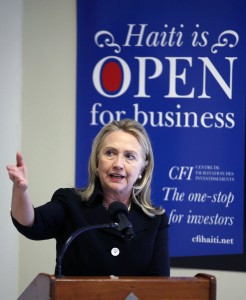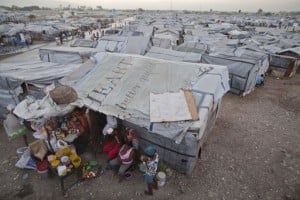Haiti “Reconstruction”: Luxury Hotels, Sweat Shops and Deregulation for the Foreign Corporate Elite
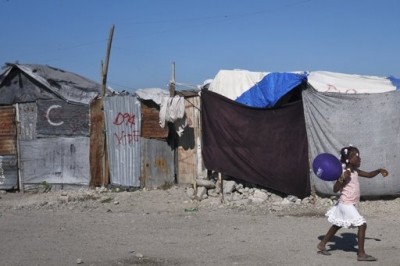
This article was first published on August 16, 2013. Today Haiti commemorates the 5th anniversary of the devastating earthquake.
Picture: Girl in a displacement camp, January 2013. REUTERS, Swoan Parker
“The international community is so screwed up they’re letting Haitians run Haiti.” –Luigi R. Einaudi, US career diplomat, member of the Council on Foreign Relations and former Assistant Secretary General at the Organization of American States
Haitian author and human rights attorney Ezili Dantò heard Luigi R. Einaudi make this shocking comment in 2004, as Haiti was about to celebrate its 200 years of independence with its first democratically elected President, Jean-Bertrand Aristide. Apart from his efforts to raise the minimum wage and other social measures for the majority of Haitians living in extreme poverty, Aristide planned to nationalize his country’s resources, a move which meant more money for Haitians and less for multinationals. One month later, in the name of the “international community”, Aristide was overthrown in a coup d’état orchestrated by the U.S., France and Canada.
Today, the “international community” is running Haiti again, colonial style.
One can easily tell by comparing the very slow construction of shelters and basic infrastructure for the Haitian majority with the rapid rise of luxury hotels for foreigners, sometimes with the help of aid funds which, we were told, were going to provide Haitians with basic necessities.
Most of the aid money went to donor countries’ businesses, government agencies and NGOs, as usual. International “aid” is a well-known capitalist scheme aimed at developing markets in the global south for businesses from the North. Of course this “aid” will benefit Haitians. But only the very few elite ones: those in power and the rich corporate elite. “Haiti’s open for business” and deluxe hotels will be welcoming businessmen so they can set up their sweat shops in a cool and luxurious environment.
Picture (left): Original caption “Back in 2011, the U.N. and Oxfam promised that a new system of cisterns and kiosks would soon provide residents with water from the state water agency. Two years later, the faucets remain dry [see photo]. Residents buy water at 5 gourdes (about US$0.12 cents) a bucket from private vendors or from the committees that manage the few still-functioning water “bladders” left over from the camp’s early days when water and food were free and when agencies provided “cash for work” jobs and start-up funds for would-be entrepreneurs.” (Reconstruction’s Massive Slum Will Cost “Hundreds Of Millions” Reconstruction’s Massive Slum Will Cost “Hundreds Of Millions” Haiti Grassroots Watch, June 17, 2013)
“Several new luxury hotels in Haiti”
A year ago the Clinton-Bush Haiti Fund invested humanitarian aid money in a five star hotel, as some 500,000 Haitians were still in displaced camps:
Picture (right): Oasis Hotel, Petionville Haiti
As part of the country’s “Reconstruction”, The Clinton-Bush Haiti Fund recently invested $2 million in the Royal Oasis Hotel, a deluxe structure to be built in a poverty-stricken metropolitan area “filled with displaced-persons camps housing hundreds of thousands”. (Julie Lévesque, HAITI: Humanitarian Aid for Earthquake Victims Used to Build Five Star Hotels, Global Research, June 28, 2012)
Now, as 300,000 Haitians are still living in camps, a “new Marriott hotel rising from the rubble in Haiti is getting a $26.5 million financial boost” from the International Financial Corporation (IFC), member of the World Bank Group:
Marriott International and telecom giant Digicel broke ground on the hotel last year, and it is expected to open in 2015. It will be among several new luxury hotels in Haiti after the devastating Jan. 12, 2010 earthquake. Spain’s Occidental Hotels & Resort and U.S.-based Best Western have both opened hotels in the last six months in Petionville, a Port-au-Prince suburb. Spanish hotel chain NH Hotels also will open a new El Rancho in Petionville over the next few months.
IFC officials say the Marriott’s construction is expected to create about 300 jobs. The hotel itself will offer 200 permanent jobs. Marriott Hotels & Resorts will operate the hotel under a long-term management agreement.
The IFC currently has about $78.5 million worth of investments in Haiti, which continues to limp toward recovery more than three years after the quake nearly wiped out its economy. The investments are aimed at creating jobs, access to basic infrastructure, and income opportunities for Haitians, the IFC said.
“Haiti has the fundamental conditions for sustainable economic growth, including a competitive workforce, proximity to major markets, and unique cultural and tourist attractions,” said Ary Naim, IFC Representative for Haiti. “With our long-term financing support for this new and important piece of business infrastructure, we are confirming our commitment and confidence in Haiti’s future.” (Jacqueline Charles New Marriott under construction in Haiti getting financial boost, Miami Herald, July 3, 2013)
Picture: Best Western Petionville, Haiti.
How a luxury hotel in a rich suburban area helps give the 300,000 displaced and most impoverished Haitians “access to basic infrastructure” has yet to be demonstrated. Moreover, it won’t create jobs for those who need it the most. It is very unlikely that a deluxe hotel in the plush suburb of Petionville will hire many poor, needy, often illiterate Haitians who only speak Creole to work for rich foreigners. These people are the “competitive work force” and end up in sweat shops and mines. What “competitive workforce” and “proximity to major markets” actually mean is “cheap labor for the U.S.”
On its web site the IFC says its investments are “focused on helping rebuild Haiti and reactivate growth through investment and advisory services, in priority sectors such as garment, infrastructure, telecom, tourism, and finance.” In addition to the $26.5 million for the Marriott, the IFC has invested $7.7 million to the aforementioned Oasis hotel, also located in Petionville. (IFC Investment Generation in Haiti)
In total, almost half of IFC investments have helped the construction of deluxe hotels in a rich suburb, home to the Haitian elite.
The World Bank: An Imperial Tool
The IFC is part of the World Bank Group. The World Bank has been criticized for previous initiatives like the Project for Participatory Community Development (PRODEP). An eight month investigation by Haiti Grassroots Watch found that PRODEP “helped undermine an already weak state, damaged Haiti’s ‘social tissue,’ carried out what could be called ‘social and political reengineering,’… raised questions of waste and corruption… contributed to Haiti’s growing status as an ‘NGO Republic’… damaged traditional solidarity systems and in some cases even strengthened the power of local elites.” (World Bank “success” undermines Haitian democracy, Haiti Grassroots Watch, December 20, 2012)
Recently, in May 2013, Alexandre Abrantes, the World Bank special envoy to Haiti announced that the “World Bank is supporting the Haitian government in improving the frameworks for mining, including legal provisions which are largely considered inadequate for current requirements,” Daniel Trenton, (World Bank says its helping Haiti draft mining legislation, The Gazette, May 17, 2013)
For Ezili Dantò, the U.S. and the World Bank are simply rewriting Haiti’s constitution to benefit mining companies:
Oxfam, [the] World Bank and the other fake philanthropic folks [are] involved in protecting the interests of the one percenters, re-writing Haiti mining laws…
ARTICLE 36-5 of the Haitian Constitution, states:
“The right to own property does not extend to the coasts, springs, rivers, water courses, mines and quarries. They are part of the State’s public domain.”
Haiti’s current law doesn’t allow drilling without a signed mining convention. But US Newmont mining got a “waiver” to the current Haiti law without the approval of even the puppet Haiti legislature. Martelly signed it in violation of the Haiti Constitution. (Ezili Dantò, Haiti: US to Re-Write Haiti Constitution to Better Service the One Percent, Black Agenda Report July 2, 2013)
Haitian mineral resources alone have been estimated at $20 billion. “U.S. and Canadian investors have spent more than $30 million in recent years on exploratory drilling and other mining-related activities in Haiti.” (Trenton, op. cit.)
Slow Reconstruction, Slave Labor and the International Aid Deception
Picture left: Jean-Marie Vincent camp, January 2013. AP/Dieu Nalio Chery
Unlike the fast-growing luxury hotel industry, the reconstruction efforts face many delays and various financial hurdles. Last June, a U.S. Government Accountability Office (GAO) report criticised USAID for its lack of transparency, multiple delays, cost overruns and reduced goals. The report points to a striking paradox: although the sums allocated to sheltering have almost doubled, the number of houses to be built has been reduced by an astonishing 80 percent:
In 2010, just months after Haiti was struck by a devastating earthquake, the United States passed legislation allocating $651 million to USAID to support relief and reconstruction efforts. Three years later, just 31 percent of these funds have been spent as delays mount and goals are scaled back… The report also criticizes USAID for a lack of transparency…
The GAO found that inaccurate cost estimates and delays led to an increase in the amount dedicated to providing shelter from $59 million to $97 million while at the same time “decreased the projected number of houses to be built by over 80 percent, from 15,000 to 2,649.” Originally estimated to cost less than $10,000 for a completed house, actual costs have been greater than $33,000. USAID has awarded over $46 million to contractors for housing. Meanwhile, some 300,000 people remain in camps over three years after the earthquake. Overall, the humanitarian community has constructed just 7,000 new homes, about 40 percent of what is currently planned…
Further, the GAO report is critical of U.S. investments supporting the Caracol Industrial Park. Randal C. Archibold of the New York Times reports:
A big portion of Agency for International Development money, $170.3 million, went toward a power plant and port for an industrial park in northern Haiti that was the centerpiece of United States reconstruction efforts and had been heavily promoted by the State Department and former President Bill Clinton…
Although the aid agency completed the power plant under budget, the port, crucial to the industrial park’s long-term success, is two years behind schedule “due in part to a lack of U.S.A.I.D. expertise in port planning in Haiti,” the report said, and is now vulnerable to cost overruns. (GAO Report Critical of USAID in Haiti, Bolsters Calls for Increased Oversight, Center for Economic and Policy Research, June 26, 2013)
The delays and potential cost overruns related to the construction of Caracol’s essential port are easily explained by the fact that USAID received $72 million for its planning and construction, despite its cruel lack of expertise. Indeed USAID has not built such a structure in the past 40 years:
Despite having “not constructed a port anywhere in the world since the 1970s”, USAID allocated $72 million dollars to build one, according to [the] GAO report released last week. The port is meant to help support the Caracol Industrial Park (CIP) which was constructed with funding from the Inter-American Development Bank (IDB) and $170 million in funding from the U.S. for related infrastructure. The CIP has been held up as the flagship reconstruction project undertaken by the international community in Haiti. Even after putting aside criticisms of the location, types of jobs and the environmental impact of the CIP, the “success” of the entire project hinges on the new port…
Without any in-house expertise in port construction at USAID, the mission turned to private contractors. HRRW reported in January 2012 that MWH Americas was awarded a “$2.8 million contract to conduct a feasibility study for port infrastructure in northern Haiti.” The expected completion date was May 2012. MWH Americas had previously been criticized for their work in New Orleans, with the Times-Picayune reporting that MWH had “been operating for more than two years under a dubiously awarded contract that has allowed it to overbill the city repeatedly even as the bricks-and-mortar recovery work it oversees has lagged.” (USAID’s Lack of Expertise, Reliance on Contractors Puts Sustainability of Caracol in Doubt, Center for Economic and Policy Research, July 2, 2013)
These examples illustrate perfectly what “international aid” is all about. Ezili Dantò explains:
The NGOs carry out US imperial policies in Haiti in exchange for “charity funding” – which means, they money launder US tax payer and donor dollars and put it in their pockets. US imperial policies is about destroying Haiti manufacturing and local economy, expropriating Haiti natural resources and making a larger Haiti market for their subsidized Wall Street monopolies.
The economic elites made billions upon billions before the $9-billion the US “big-hearted humanitarians” would add to their coffers from laundering earthquake relief dollars largely back to US groups.
But the NGOs and their Hollywood, media and academic cohorts play firemen to the US government’s arsonist role in Haiti and the global south. The professional posers – the white industrial charitable complex – play an underhanded game. For instance “The Center for Economic and Policy Research (CEPR) analyzed the $1.15 billion pledged after the January 2010 quake to Haiti and found that the “vast majority” of the money it could follow went straight to U.S. companies or organizations, more than half in the Washington area alone.” (Ezili Dantò, op. cit.).
“Haitians earn less today than they did under the Duvalier dictatorship”
The giant Caracol Industrial Park was inaugurated in March 2013 in the presence of President Martelly, as well as “Haitian and foreign diplomats, the Clinton power couple, millionaires and actors, all present to celebrate the government’s clarion call: ‘Haiti is open for business.’” (The Caracol Industrial Park: Worth the risk? Haiti Grassroots Watch, March 7, 2013)
Caracol was promoted as a way to decentralize the country and potentially create between 20,000 and 65,000 jobs. The results one year later are far from expectations:
One year after it started operations, only 1,388 people work in the park… Also, HGW research amongst a sampling of workers found that at the end of the day, most have only 57 gourdes, or US$1.36, in hand after paying for transportation and food out of their minimum wage 200-gourde (US$4.75) salary.
HGW also learned that most of the farmers kicked off their plots to make way for the park are still without land.
“Before, Caracol was the breadbasket of the Northeast department,” said Breüs Wilcien, one of the farmers expelled from the 250-hectare zone. “Right now there is a shortage of some products in the local markets. We are just sitting here in misery.” (Ibid.)
Destroying food sovereignty in the global south is a common practice used by the global north through international bodies like the World Bank and the IMF. The goal is to keep the South dependent on the North and create a market for exportation, deceptively labelled “food aid” for photo ops and to conceal the real intent: dumping.
Clearly, in addition to providing slave labor for U.S. and other foreign garment companies, the Caracol Industrial Park has contributed to reduce even more what remains of the local farming in Haiti, eradicated over the years by a barbaric U.S. foreign policy. A 2010 report from the Council on Hemispheric Affairs found that Haiti’s “savior” “President Clinton and other recent White House tenants [condemned] Haiti to a future of endemic poverty through a self-serving U.S. rice export policy.” (Leah Chavla, Bill Clinton’s heavy hand on Haiti’s vulnerable agricultural economy: The American rice scandal, Council on Hemispheric Affairs, April 13, 2010)

Picture: Notice workers who earn less than $5 a day do not smile. Clinton is the only one smiling. Original caption: “Former U.S. President and U.N. Special Envoy to Haiti, Bill Clinton, smiles as he is greeted by garment workers at the Caracol Industrial Park Monday, Oct. 22, 2012, in Caracol, Haiti. The industrial park in northern Haiti is expected to create up to 65, 000 new jobs. It is a $300 million initiative by the governments of Haiti, the U.S. and the Inter-American Development Bank.” (Clintons visit Haiti to inaugurate new industrial park, The Bee. Picture: Carl Juste, Miami Herald)
Haiti expert Isabeau Doucet notes:
In the 1950s, agriculture made up 90 per cent of Haiti’s exports; today, 90 per cent of exports are from the apparel sector, while more than half the country’s food is imported…
Preferential free-trade deals signed between Haiti and the United States—named HOPE (Haitian Hemispheric Opportunity through Partnership Encouragement Act, 2006), HOPE II (2008) and HELP (Haiti Economic Lift Program, 2008)—have been part of a push to expand Haiti’s apparel industry by branding “Made in Haiti” garments as somehow humanitarian, socially responsible, and good for Haiti’s “development,” while also giving duty-free access to US markets.
According to a 2011 study by the American Federation of Labor and Congress of Industrial Organizations (AFL-CIO), the estimated cost of living in Port-au-Prince is $29 a day. Two hundred gourdes for an eight-hour work shift is one-sixth the AFL-CIO’s estimated living wage. Transport to and from work and a modest lunch could easily cost a worker 120 gourdes. Indeed, Haitians earn less today than they did under the Duvalier dictatorship; wages have barely increased and are worth half their 1984 purchasing power. (Isabeau Doucet, Made in Haiti, Dumped in Haiti: Slave Labor and the Garment Industry, The Dominion 10 July 2013)
Displaced people dumped on a wasteland
While the tourism industry is rapidly growing, people have been evicted from the city and dumped on a wasteland in a camp called Corail-Cesselesse, also known as “Canaan,” “Jerusalem” and “ONAville”. The camp on the outskirts of Port-au-Prince could “become the country’s most expansive – and most expensive – slum” where there are no jobs and water is hard to find.
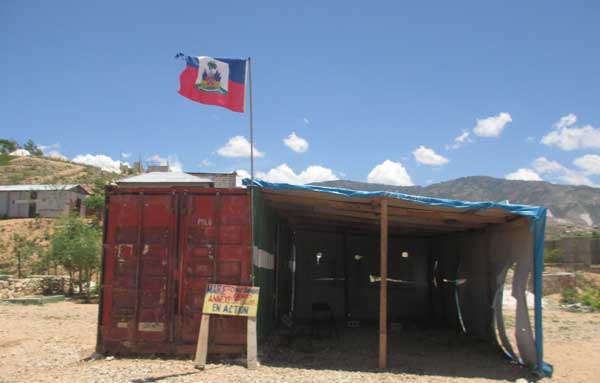
Picture: City Hall annex in Croix-des-Bouquets, Canaan.
Today, all of the big agencies have abandoned the Corail camp and its 10,000 residents. Trumpeting their success and claiming to have prepared a “transition” to the local authorities, [International Organization of Migration] IOM, [American Refugee Committee] ARC and World Vision all pulled out (although World Vision still supports the Corail School, which it built). (Reconstruction’s Massive Slum Will Cost “Hundreds Of Millions” Reconstruction’s Massive Slum Will Cost “Hundreds Of Millions” Haiti Grassroots Watch, June 17, 2013)
The international community is not helping rebuild Haiti. It is improving colonialism in Haiti with its companies, using the country’s population as slave labor to boost profits. The startling difference between the slow reconstruction efforts for Haitians as opposed to the rapid rise of the luxury hotel industry shows that in Haiti, the foreigners come first. Sadly white supremacy and slavery are still alive and well in the “pearl of the Antilles”.


